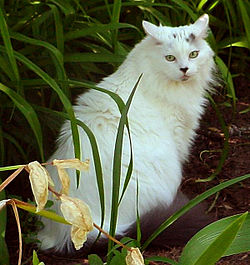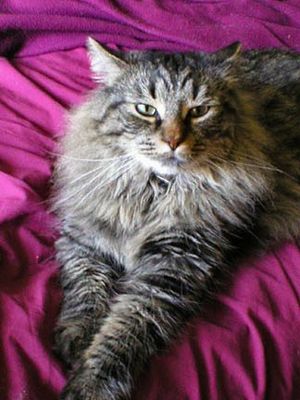Maine Coon: Difference between revisions
imported>Nancy Sculerati MD m (→Origin) |
imported>Nancy Sculerati MD (→Origin) |
||
| Line 19: | Line 19: | ||
==Origin== | ==Origin== | ||
In the 16th and 17th centuries, domestic cats were brought to North America from Europe. Those that arrived in New England faced very severe winters, where only the strongest and most adaptable cats survived. Through natural selection (as opposed to selective breeding), the Maine Coon developed into a large, rugged cat with a water-resistant, thick coat and a hardy constitution. The origin of the breed (and its name) has several, often fantastic, stories surrounding it. One comes from a legend that a domestic cat released in the wilds of [[Maine]] interbred with a [[raccoon]], resulting in offspring with the Maine Coon's characteristics. Though biologically impossible, this myth, | In the 16th and 17th centuries, domestic cats were brought to North America from Europe. Those that arrived in New England faced very severe winters, where only the strongest and most adaptable cats survived. Through natural selection (as opposed to selective breeding), the Maine Coon developed into a large, rugged cat with a water-resistant, thick coat and a hardy constitution. The origin of the breed (and its name) has several, often fantastic, stories surrounding it. One comes from a legend that a domestic cat released in the wilds of [[Maine]] interbred with a [[raccoon]], resulting in offspring with the Maine Coon's characteristics. Though biologically impossible, this myth, is attractive because of the raccoon like appearance that the bushy tail and the most common coloring (brown tabby) gives the breed , along with its rather singular habit of using its paws to pick up food. Those similarities could probably led to the adoption of the name 'Maine Coon' in the first place. An alternative explanation for the name is the claim that local folks called these cats by the surname of a ship's master, a so-called "Captain Coon", who brought the breed along with him to Maine shores. One of the most lyrical stories is that the breed sprang from the six pet cats which [[Marie Antoinette]] sent to [[Wiscasset, Maine]] when she was planning to escape from France during the French Revolution. | ||
Whether or not Marie Antionette ever petted the ancestors of the Maine Coon, there is no doubt that a recessive [[allele]] for long hair in the gene pool of European domestic cats at the time, and that those animals who inherited a pair of the "long-hair" genes for this trait, giving them a luxuriously fluffy coat, were prized over and above their short-haired brethren (who had inherited one or none). Because of the existance of domestic short-hair cats in Europe who carried a recessive gene for long hair, it's quite possible that all of the ancestors of the Maine Coon were short-haired, but that some of their kittens were long-haired, and natural selection favored these to survive and breed. | |||
Most Main Coon breeders today believe that the breed originated in matings between pre-existing shorthaired domestic cats and overseas longhairs (perhaps Angora types introduced by New England seamen, or longhairs brought to America by the Vikings). Maine Coons' long coats resemble their [[Europe|European]] counterparts, the [[Norwegian Forest Cat]]s. Maine Coons are known as the gentle giant.[[Image:maine1.jpeg|thumb|left|The coat is spectacular]] | |||
==Physical characteristics== | ==Physical characteristics== | ||
Revision as of 10:32, 12 December 2006
| Maine Coon |
|---|
| Country of origin |
| United States |
| Breed standards (external links) |
| AACE, CFA, ACFA, TICA, CCA, ACF, GCCF, FIFe |
The Maine Coon is one of the largest breeds of domestic cat, known for its intelligence, playfulness as well as distinctive physical appearance. The breed is one of the oldest natural breeds in North America and originated from New England, making it America's first indigenous show cat.
Origin
In the 16th and 17th centuries, domestic cats were brought to North America from Europe. Those that arrived in New England faced very severe winters, where only the strongest and most adaptable cats survived. Through natural selection (as opposed to selective breeding), the Maine Coon developed into a large, rugged cat with a water-resistant, thick coat and a hardy constitution. The origin of the breed (and its name) has several, often fantastic, stories surrounding it. One comes from a legend that a domestic cat released in the wilds of Maine interbred with a raccoon, resulting in offspring with the Maine Coon's characteristics. Though biologically impossible, this myth, is attractive because of the raccoon like appearance that the bushy tail and the most common coloring (brown tabby) gives the breed , along with its rather singular habit of using its paws to pick up food. Those similarities could probably led to the adoption of the name 'Maine Coon' in the first place. An alternative explanation for the name is the claim that local folks called these cats by the surname of a ship's master, a so-called "Captain Coon", who brought the breed along with him to Maine shores. One of the most lyrical stories is that the breed sprang from the six pet cats which Marie Antoinette sent to Wiscasset, Maine when she was planning to escape from France during the French Revolution.
Whether or not Marie Antionette ever petted the ancestors of the Maine Coon, there is no doubt that a recessive allele for long hair in the gene pool of European domestic cats at the time, and that those animals who inherited a pair of the "long-hair" genes for this trait, giving them a luxuriously fluffy coat, were prized over and above their short-haired brethren (who had inherited one or none). Because of the existance of domestic short-hair cats in Europe who carried a recessive gene for long hair, it's quite possible that all of the ancestors of the Maine Coon were short-haired, but that some of their kittens were long-haired, and natural selection favored these to survive and breed.
Most Main Coon breeders today believe that the breed originated in matings between pre-existing shorthaired domestic cats and overseas longhairs (perhaps Angora types introduced by New England seamen, or longhairs brought to America by the Vikings). Maine Coons' long coats resemble their European counterparts, the Norwegian Forest Cats. Maine Coons are known as the gentle giant.
Physical characteristics
Maine Coons are very large and energetic cats, sometimes weighing 11.3 kilograms (25 pounds); the average weight is 6 to 9 kilograms (13-20 pounds) for adult males and less (7-11 pounds) for females. Male Maine Coons may grow to a length in excess of 1 metre (40 inches); the longest cat on record is a Maine Coon 121cm (49 inches) in length.[1] Growth to full size often takes longer than for most cats, with Maine Coons usually reaching full size at age three or four.
The most common color/pattern in the breed is brown with tabby markings. Maine Coons are recognized in all colors, including tortoiseshell, except for chocolate, lavender, ticked tabby, and the point-restricted ("Siamese") pattern. Eye color also varies widely. All patterns may have green, green-gold, or gold. Blue eyes, or one blue eye with one gold eye, are possible in white coat cats.
Maine Coons have medium-long, dense fur, with longer hair, or a ruff, on their chests similar to the mane of a lion (which is why the breed is sometimes humorously called the "Mane Coon"). Their fur consists of two layers - an undercoat and an additional layer of longer guard hairs, which gives the breed their key physical feature. The fur is generally very soft. Maine Coons have long hair on the backs of their legs (called pantaloons or britches) and between their toes which helps to keep warm in the cold. They also have bushy plumed tails and broad, angular heads, squared-off muzzles and wide-set ears topped with tufts of fur. Most Maine Coons keep their fur in good order without the need for additional human grooming, but due to the length and quantity of hair, most will also benefit from a simple brushing once a week. While the Coon may be polydactyl, having one or more extra toes on their paws, this trait is generally bred out.
They have especially large and furry tails, and have been called "the tail with the cat attached".
Behavioral characteristics
Maine Coons are a breed distinguished by intelligence, dexterity and playfulness. They have a tendency to use their front paws extensively (often curling the paw round to pick objects up) and as a consequence will easily learn to open cabinet doors, turn on water faucets, or pick up small objects. Some Maine Coons will eat from their paws, rather than eating from the bowl itself.
Due to their above-average intelligence, Maine Coons are known to be one of the easiest cat breeds to train. Maine Coons are noted for their ability to trill their meows, which sounds like a combination of a purr and a meow, and they tend to make this sound when happy or startled. They are noted for rarely eating alone, preferring to eat in the company of other cats or humans. Maine Coons are usually not "lap" cats, and many Maine Coons, possibly because of their size, are not comfortable with sitting on a person's lap or chest, though this may depend on the personality of the individual cat.
Some Maine Coons enjoy playing with, but not usually in, water. They may dip toys in their water bowls before playing with them, or just tip the water bowl over. They may also skim their paws across the surface of their water bowl. Maine Coons occasionally engage in mischievous behavior when bored, such as deliberately pushing things off tables and the tops of refrigerators with their paws.
Maine Coons can be very dog-like in their behavior. Playing fetch is a favorite game. As with dogs, they will bring their ball, drop it at the feet of their intended playmate and wait for the ball to be thrown.
Health considerations
A genetic predisposition towards hypertrophic cardiomyopathy appears in some genetic lines of the Maine Coon population. In extreme cases, this condition can result in the sudden death of what appears to be an otherwise healthy animal. It can be detected by regular cardiac ultrasounds of pets between the ages of 3 and 6, the age at which the disease becomes detectable. Responsible breeders, in an effort to reduce the occurrence of HCM, now screen their animals long-term and make this information available to potential pet buyers.
In the past, Taurine deficiency was a common cause of dilated cardiomyopathy in all cats, including Maine Coons. Since the pet food industry started adding Taurine to cat food, this kind of cardiomyopathy is increasingly rare. Taurine-related cardiomyopathy can be cured with the addition of the nutrient to the diet, but genetic HCM causes a permanent enlargement of the left ventricle and is rarely treatable.
Other potential health problems include hip dysplasia and Polycystic Kidney Disease. However, Maine Coons are generally quite healthy and resilient animals.
References
External links
- Burke's Backyard (Australian TV program) road-test report on the Maine Coon.
- Maine Coon Cat Breed FAQ.
- Oral history of the Maine Coon.
- Maine Coon Heritage Site.
- The Online Cat Guide's Maine Coon Description
- Feline Hypertrophic Cardiomyopathy
da:Maine Coon de:Maine-Coon-Katze fr:Maine Coon it:Maine Coon he:מיין קון nl:Maine Coon ja:メインクーン pl:Maine Coon pt:Maine Coon sk:Mainská mývalia mačka fi:Maine coon sv:Maine coon

